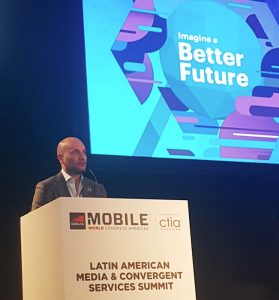Regional industry leaders met at Latin American Media & Convergent Services Summit, held at Mobile World Congress Americas, to analyse how the rise of mobile media transforms the digital ecosystem, fuels innovation and develops new value chains
14 September 2018, Los Angeles: According to the GSMA’s latest Global Mobile Trends report, published at Mobile World Congress Americas this week, smartphones now account for 65 per cent of Latin America’s 717 million mobile connections, up from just 23 per cent five years ago. More than a third of connections (35 per cent) are running on 4G. Driven by faster devices and networks, the region followed the worldwide uptrend in mobile video consumption; video is already the main generator of traffic (56 per cent) and it’s expected to grow by around 45 per cent annually through 2023 to account for 73 per cent of all mobile data traffic. With more people than ever watching online video on the small screen, new forms of content creation and distribution are emerging, disrupting the mobile and media landscape.
The emerging intersection between mobile technology and video was the central theme of the Latin American Media & Convergent Services Summit which took place on September 13 at Mobile World Congress Americas. The summit brought together telecom executives and officials, media leaders and startup innovators to discuss possible alliances, business opportunities and regulatory hurdles in the region. Leaders from Telecom Argentina, Anatel Brasil, Verizon, VUBIQUITY, Raze, Viacom, Legendary and Wolox, among others, participated in the panels.
 “As mobile takes the lead in video viewing, convergence between telecommunications and other media intensifies. The emergence of quad-play services in Latin America has opened the door to new services based around content and it’s also spurring new forms of collaboration among mobile operators, media groups, OTTs and film studios,” said Sebastián Cabello, Head of Latin America, GSMA. “Consumers’ appetite for mobile entertainment is not only a game changer for mobile operators and media corporations, it also encourages the participation of entirely new players that can help develop local ecosystems.”
“As mobile takes the lead in video viewing, convergence between telecommunications and other media intensifies. The emergence of quad-play services in Latin America has opened the door to new services based around content and it’s also spurring new forms of collaboration among mobile operators, media groups, OTTs and film studios,” said Sebastián Cabello, Head of Latin America, GSMA. “Consumers’ appetite for mobile entertainment is not only a game changer for mobile operators and media corporations, it also encourages the participation of entirely new players that can help develop local ecosystems.”
Disruptive local content projects promote the emergence of brand-new value chains, the creation of jobs and the advent of inventive revenue streams. Opportunities are not limited to traditional media; virtual, mixed and augmented reality, for example, provide a great platform for mobile-powered innovation.
Apart from generating business opportunities, convergence can also contribute to bridge the digital divide. The GSMA’s Global Mobile Trends report reveals that there’s still a significant gap between mobile internet coverage and usage in Latin America. In Brazil, for example, 79 million people are covered by 3G or 4G but not connected; this is also the case for 53 million Mexicans and 23 million people in Colombia. The largest barrier to mobile internet is a lack of relevant content for the unconnected population; therefore, the creation of new locally useful apps, tools or entertainment matching local needs and culture could help bring more people online.
Operators’ Investment Focus
According to GSMA Intelligence, mobile operators in Latin America are currently investing more than $15 billion a year (capex) in building out new networks, mainly 4.5G. By 2025, it is forecast that 4G will account for 64 per cent of connections. By that point, commercial 5G networks will have been launched and will account for about 8 per cent of the regional total.